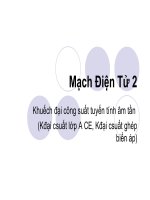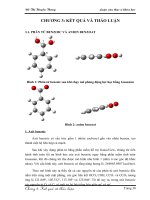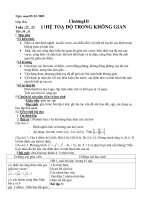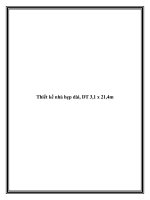3 1 well control
Bạn đang xem bản rút gọn của tài liệu. Xem và tải ngay bản đầy đủ của tài liệu tại đây (470.1 KB, 54 trang )
Network of Excellence in Training
Basic Well Control
© COPYRIGHT 2001, NExT.
All Rights Reserved
Basic Well Control
• Lecture Contents;
– Lecture Objectives,
– Introduction,
– Primary Control,
– Warning Signs of Kicks,
– Secondary Control,
– Well Killing Procedures,
– Kill Sheet.
2
© COPYRIGHT 2001,
.
All Rights Reserved
Basic Well Control
• Lecture Objectives
– At the end of this lecture YOU will be able to:
• Define the term “kick”,
• State warning signs of a kick,
• Describe the drawback of uncontrolled kicks,
• State primary and secondary control procedures,
• List well killing procedures and the various calculation to
fill-up the well control work sheet.
3
© COPYRIGHT 2001,
.
All Rights Reserved
Basic Well Control
• Introduction;
– In simple terms, kick occur when the formation pressure
exceeds the mud hydrostatic pressure,
– The resultant negative differential pressure is forced into
the wellbore,
– If the flow of the kick is controlled then the well is killed,
– Blow-out occurs when the kick (influx) is uncontrolled,
– The rig crew must be alert all times in order to take
immediate action to bring the well under control.
4
© COPYRIGHT 2001,
.
All Rights Reserved
Basic Well Control
• Introduction;
– Uncontrolled Kick !
5
© COPYRIGHT 2001,
.
All Rights Reserved
Basic Well Control
• Introduction;
– And result result !
6
© COPYRIGHT 2001,
.
All Rights Reserved
Basic Well Control
Causes of Kicks
1. Tripping
2. Drilling into an
overpressured zone
3. Failure to fill hole
4. Inadequate mud weight
5. Gas cut mud
6. Lost circulation
7
© COPYRIGHT 2001,
.
All Rights Reserved
Basic Well Control
A study of 55 blowouts during a 10-year period
lists the following primary causes of blowouts:
Cause
% of Total
Failure to keep hole full
42
Insufficient Mud weight
15
Lost Circulation
22
Swabbing
16
Other
5
8
© COPYRIGHT 2001,
.
All Rights Reserved
Basic Well Control
Mud
hydrostatic
pressure
Pf
Pressure Changes During A Kick
9
© COPYRIGHT 2001,
.
All Rights Reserved
Basic Well Control
Mud
hydrostatic
pressure
New
heavy
mud
Pf
Pressure Changes During A Kick
10
© COPYRIGHT 2001,
.
All Rights Reserved
Basic Well Control
Imagine we applied a
surface pressure of
Mud
hydrostatic
pressure
100
psi
Pf
Pf – hydrostatic = say
100 psi on surface
Bottomhole
pressure changes
by same amount
Pressure Changes During A Kick
11
© COPYRIGHT 2001,
.
All Rights Reserved
Basic Well Control
Pdp = Pf- mud hydrostatic
Mud
hydrostatic
pressure
During a kick the
reverse happens…
downhole pressure is
seen at surface
Pf
Formation pressure = mud hydrostatic pressure + Pdp
12
© COPYRIGHT 2001,
.
All Rights Reserved
Basic Well Control
– Kick due to Overpressured Zone:
Depth
Mud Pressure
Normal Pressure
Formation Pressure
Overpressure
Pressure
13
© COPYRIGHT 2001,
.
All Rights Reserved
Basic Well Control
– Reduction in hydrostatic pressure due to fluid level drop
in borehole:
Depth
Mud Pressure
Pore Pressure
14
Pressure
© COPYRIGHT 2001,
.
All Rights Reserved
Basic Well Control
DPSIP
Well Shut-in
Before circulation
Pa
Mud
Gas
Yf
Pf
15
© COPYRIGHT 2001,
.
All Rights Reserved
Basic Well Control
Remedy
Before normal operations ca resume:
1.
The influx has to be removed from the
annulus
2.
Mud hydrostatic has to balance the
formation
16
© COPYRIGHT 2001,
.
All Rights Reserved
Basic Well Control
• Primary Control;
– The aim of primary control is to prevent the influx of
formation fluids into the wellbore by keeping sufficient
hydrostatic pressure,
– There are two ways in which primary control can be lost:
• Low mud weight,
• Reduction of the mud column.
17
© COPYRIGHT 2001,
.
All Rights Reserved
Basic Well Control
• Primary Control;
– Low Mud Weight:
• The mud weight maybe too low for the following reason:
– Drilling through an overpressured zone that required a
heavier mud,
– Inaccurate measurement of fluid density,
– Excessive dilution of the mud,
– Gas cut of the mud,
– Solids removal.
18
© COPYRIGHT 2001,
.
All Rights Reserved
Basic Well Control
• Primary Control;
– Reduction of the Mud Column:
• This is due to the following scenarios:
– Swabbing:
» This is the process by which the drillpipe acts as a
piston upward,
– Lost circulation:
» This occurs when a fractured formation is being drilled,
it can be either natural or induced fractures.
19
© COPYRIGHT 2001,
.
All Rights Reserved
Basic Well Control
• Warning Signs of Kicks;
– Primary Indicators:
• Flowrate increase:
– While the mud pumps are circulating at a constant rate, there
should be a constant flowrate of mud returns to surface,
– If the flowrate increases, this will be an indication that
formation fluids are fed into the wellbore.
• Pit Volume Increase:
– When active pit level increases. This will be a sign that an
influx has been entered the wellbore,
– The influx volume is equal to the pit gain and should be
noted for later calculations.
20
© COPYRIGHT 2001,
.
All Rights Reserved
Basic Well Control
• Warning Signs of Kicks;
– Primary Indicators:
• Flowing Well with Pumps Shut-off:
– When rig pumps are not operating, there should be no returns,
– If the well flows, a flow check must be carried-out to verify
whether it is due to either thermal expansion, U-tube affect, or an
influx.
• Improper Hole Fill-Up During Trips:
– The hole should be filled when the pipe is tripped-out,
– If the pipe displacement volume has not been replaced, then this
will indicate that the mud has been displaced by the formation
fluids.
21
© COPYRIGHT 2001,
.
All Rights Reserved
Basic Well Control
• Warning Signs of Kicks;
– Secondary Indicators:
• Change in Pump Pressure & Flowrate:
– An entry of an influx to the wellbore will reduce the mud
hydrostatic pressure and hence the pump flowrate will
increase.
• Drilling Break:
– A sudden increase in the rate of penetration could indicate an
entrance to an overpressured zone (bearing in mind
formation change, or change in drilling parameters)
22
© COPYRIGHT 2001,
.
All Rights Reserved
Basic Well Control
Once Kick is Detected by;
Increase in flow rate out of the
hole
Increase in surface mud
volume ( pit volume)
Driller has to close Blowout Preventer
ASAP
23
© COPYRIGHT 2001,
.
All Rights Reserved
Basic Well Control
• Secondary Control;
– Shut-in procedure:
• For a kick detected while drilling:
– Raise kelly above rotary table until tool joint appears,
– Stop mud pumps,
– Close Annular Preventer (or Pipe Rams),
– Record SIDPP, SICP and Pit Gain.
24
© COPYRIGHT 2001,
.
All Rights Reserved
Basic Well Control
In the 55-well study referred to earlier, evidence
showed that after the wells kicked, 62% were not
controlled for the following reasons:
Cause
% of Total
Insufficient Blowout Equipment
29
Improperly designed Blowout Equipment
5
Improper Installation
11
Improper Surface Fittings
6
Improper well, casing and cementing
program
11
25
© COPYRIGHT 2001,
.
All Rights Reserved









